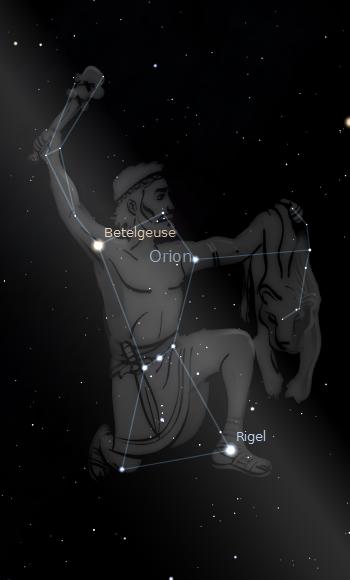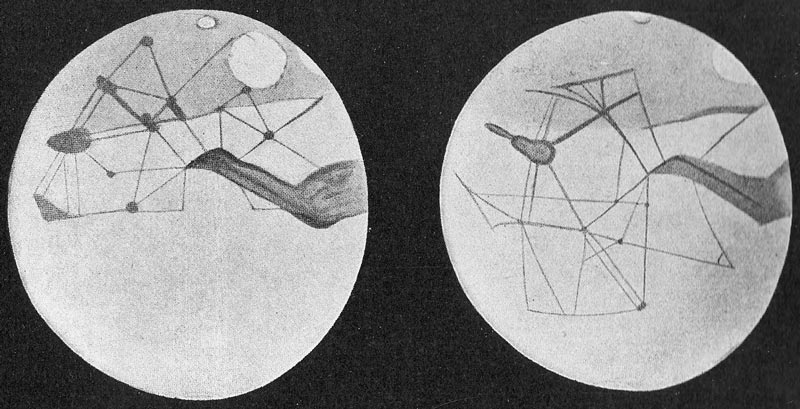With origins dating back to Homer’s epic Odyssey and one of the 48 constellations listed in Ptolemy’s Almagest, Orion provides a link for astronomy’s transformation between mythology and science. Many of the stars in Orion bear names rooted in Arabic, artifacts of the golden age of Islamic astronomy from 800 – 1450 A.D. Presently, NASA has designated Orion as the title for its deep space vehicle to carry humans to destinations beyond the Moon. As the winter solstice approaches, the most famous constellation begins to make its appearance high in the evening sky. Orion contains a rich tapestry of stars, nebulae, and history.

In early December, Orion rises above the eastern horizon around 7 PM. As the winter progresses, Orion rises earlier and earlier, meaning its zenith in the sky falls in the early evening hours making its visibility very prominent to anyone out and about at night. Located on the celestial equator, adjacent to the zodiacal constellations Gemini and Taurus, Orion is observable in both the Northern and Southern Hemispheres. The main seven stars are red or blue giants and are very luminous. To put the brightness of these stars in perspective, lets compare them to the Sun using a Hertzsprung-Russell (H-R) diagram.

The Sun is represented by the yellow dot. You will note one of the quirks in the H-R diagram is that temperature, depicted by the horizontal axis, is scaled in reverse. That means hotter stars are on the left and cooler stars are on the right. All of the major seven stars of Orion are 10,000 to 100,000 times brighter than the Sun. In fact, most of the stars you see when looking at the night sky without the aid of a telescope will be brighter than the Sun. In the case of Orion, the stars are blue-white giants with the exception of Betelgeuse which is represented by the dot to the far right of the diagram. Betelgeuse is cooler than the Sun, how could it be so much brighter? The answer lies in its size.
Betelgeuse is so large the orbit of Mars could fit inside of it. A 100-watt light bulb is brighter than a 60-watt light bulb. However, ten 60-watt light bulbs are brighter than a single 100-watt light bulb. That is why Betelgeuse, despite being a relatively cool 3,500 K, is so luminous. Betelgeuse is a red giant, which means it is in the latter part of its life. A star becomes a red giant when all the hydrogen in its core has been burned up. As a star begins to fuse helium, the core becomes hotter, expanding the star much like hot air expands a balloon. Eventually, Betelgeuse will go supernova. Will we see this event? It’s possible, but not probable. A recent estimate predicts the supernova to occur in 100,000 years. To put that in perspective, the pyramids of Ancient Egypt were built about 5,000 years ago. But that’s not to say Betelgeuse is not interesting to observe now.
Looking at Orion, Betelgeuse occupies the upper left corner. Most stars appear to be white to the naked eye. With Betelgeuse, one can detect its red color. Most stars are too dim to activate the cones in our eyes that can discern color. Betelgeuse provides the opportunity to see the true color of a star without a telescope and/or camera. With a telescope, Betelgeuse provided astronomers the opportunity to make it the first star whose disk was resolved beyond a point of light. In 1996, the Hubble Space Telescope imaged the surface of Betelgeuse.

Betelgeuse has attracted the curiosity of astronomers for centuries, and the roots of its distinct name is a legacy of that history. The word Betelgeuse is derived from the Arabic word Yad al-Jawza, which means forefront of the white-belted sheep. Many star names have their origins from the golden era of Islamic astronomy. One tip off of a word with Arabic origins is if it begins with “al”, which is equivalent to “the” in English. In Orion, the stars Alnitak (the girdle) and Alnilam (the belt of pearls) are two such examples. The Orion stars Mintaka (belt), Saiph (sword of the giant), and Rigel (rijl – foot) are also Arabic in nature. Of the seven major stars of Orion, Bellatrix is the outlier as it is derived from the Latin word for female warrior.

The Arabic influence extends into math (algebra) and computer science (algorithm). As S. Frederick Starr describes in his book, Lost Enlightenment, the epicenter of this scientific golden age was in a region of Central Asia spanning from Eastern Iran to Western China and Kazakhstan to Northern Pakistan and India. As the Islamic Empire grew during this period, Arabic became the de facto language of science much as English is today. The Islamic astronomers were among the first to begin the process of challenging Ptolemy’s Earth centric model of the universe.
Ptolemy had listed Orion as a constellation in his Almagest. Note this title begins with the letters al. As you may have surmised, this is the Arabic translation of the title which is The Greatest Compilation and translates into Arabic as al-majisti. Ptolemy wrote Almagest in 150 A.D., and it survived as the primary star catalog until 1598 when Tycho Brahe published his thousand star catalog Stellarum octavi orbis inerrantium accurata restitutio. While Ptolemy was known to dabble in astrology, Almagest was concerned with the mathematical modeling of the motions of celestial objects. The mythology of Orion predates Ptolemy by several centuries.

While it can be difficult to discern mythological patterns in most constellations, it is easy to see how the Ancient Greeks viewed Orion as a hunter. In Greek mythology, Orion’s father was Poseidon. During the early 1970’s, a movie called The Poseidon Adventure, featuring an ocean liner capsized by a tidal wave, kickstarted a decade of disaster movies. The mythological Poseidon could walk on water and Orion inherited that trait. Orion, of course, was also a great hunter. So great, in fact, he threatened to kill every animal on Earth. This caused Orion to run afoul of Gaia, the goddess of Earth, who sent a scorpion to kill Orion. Both the scorpion and Orion were placed by Zeus in the heavens. Scorpius is most prominent in the summer sky while Orion is most prominent in the winter sky. The scorpion is always chasing the hunter in the heavens.
Death and rebirth is often a theme in mythology. That is also the case in the universe. Orion the constellation is home to the Orion Nebula, at 1,340 light years away, the closest stellar nursery to Earth and home to some 1,000 newly born stars. The Orion Nebula (aka M42) is located in Orion’s sword and can be seen with the naked eye and you can take an image of it with your cellphone. When the Hubble is pointed at the Orion Nebula, it looks like this:

The glowing gas of the Orion Nebula is lit up by four massive stars which constitute the Trapezium cluster. These stars, along with the 1,000 forming stars, blast through the nebula with high stellar winds creating a cauldron of bubbles, bow shocks, and pillars of dust and gas. Along with these structures are protoplanetary disks in which systems of planets such as our Solar System may originate. The Orion Nebula is an example of how gas is recycled from stars that went supernova to build new stars. The heavy elements (elements besides hydrogen and helium) that make up the Earth and our bodies were assembled in the fusion reactions of first generation stars, then spread out into the galaxy via supernova explosions. Our Sun is a second generation star produced from the supernova remnants of a first generation star. Thus, as Joni Mitchell would say, we are stardust.
Could life exist in the stars that comprise the constellation Orion? Science fiction writers have often used Orion and its stars in their stories as the reading audience is familiar with these names. In Star Trek, there were the infamous green Orion slave women and Rigel is mentioned in several episodes. If life does exist in Orion, it would not be in planets around the main seven stars of the constellation. Those stars are either blue or red giants. Giant stars live fast and die young as they expend prodigious amounts of energy, much like a gas guzzling automobile. The lifespans of these stars are on the order of tens of millions of years. This is much shorter than the 700 million years it took single cell organisms and 4.5 billion years for intelligent life to develop on Earth. If life exists in Orion, it would be around the dimmer, Sun-like stars that usually require binoculars or a telescope to detect. These stars burn at a slower rate, giving them a lifespan of the several billion years that could enable life to evolve on an orbiting planet.
One can look up at Orion and imagine the state of human civilization in years past. Rigel is 733 light years and Betelgeuse is 642 light years, give or take a few dozen for measurement uncertainties, from Earth. A light year is the distance light travels in, you guessed it, one year. When you look at Rigel and Betelgeuse, the light photons striking your eyes began their journey from those stars during the late 1200’s and 1300’s. In other words, you are looking at those stars as they were during the waning years of the golden age of Islamic astronomy, when those stars were named. Like all societies, the Islamic Empire faced a struggle between science and mythology as the basis for knowledge.

Certainly the Ancient Greeks endured that struggle as well. Ptolemy practiced astronomy and astrology side by side. Currently, America is experiencing a distinct anti/pseudo scientific political and social movement, while at the same time NASA has named its developing deep space vehicle Orion. Often we view struggles within civilizations as ideological and/or theological conflicts. Whether a society advances scientifically depends more so on the clash between rational thought, validated by empirical evidence, and verified by independent sources against dogmatic thinking not open to critical review. History will tell you the correct path to go, and in many respects, astronomer’s attempts to understand that most prominent constellation in the sky has been side by side with that struggle.
*Image at top of post is how Orion appears in the evening sky during winter. Credit: Wiki Commons.
































































